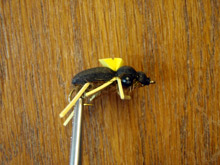BLACK FOAM BEETLE
BY TED FAUCEGLIA
Beetles belong to the order of insects known as coleoptera, which includes both the aquatic and terrestrial genera. Both genera are on the trout’s menu, but the terrestrial adults are far more significant simply because they’re much more numerous. Some terrestrial adults have elongated bodies with a noticeable separation between their thorax and abdomen, while others have integrated, olive shaped bodies. They range in sizes from 4 to 20 millimeters and sport a variety of colors but most are either dark brown or shiny black. By sheer happenstance, beetles stray into trout streams. Trapped within the surface film, there’s no escape, and the trout seem to know it. Soft rise forms under overhanging tree limbs or along the grassy edge of a stream with no visible insects in sight are a sure sign the trout are after a terrestrial insect. Usually a beetle. This calls for a flush-floating imitation attached to a long section of 6x or 7x tippet and presented with a tuck cast that duplicates the noisy “plop” of a beetle hitting the water.
HOOK - TMC 2302, (can use TMC 200R or MUSTAD C53S - Down eye works best)
THREAD - Black, 6/0
WING CASE - 2mm Black Foam (cut to shape)
BODY - Hareline olive brown ice dub. (I used SLF squirrel dubbing)
LEGS - Larva lace amber super floss.
INDICATOR - Small cut of 2mm foam yellow
EYES - Small black mono eyes (optional on smaller sizes)
HEAD - Wing case extension (cut to shape)How to Tie
- Debarb hook and mount hook in vice. Start thread about mid shank and lay a thread base to just a little bit into the hook bend. Put some zap-a-gap on the base and while it’s drying get your black foam and cut a strip about a little bigger than the hook gap then cut the end to a point. Now tie it in with the pointed part facing forward then put some zap-a-gap on it to help keep it stable.
- Bring the thread forward to about a little bit more than halfway on the shank and tie in the mono eyes with a crisscross then figure eight wraps add some zap-a-gap. Then wrap thread back to the foam body. (eyes on top of shank)
- Tie in the rear legs about halfway between the foam body and the eyes. Then bring your thread back to the foam body and dub the abdomen up to the eyes.
- Bring the foam body up and over the top of the abdomen and give it a gentle pull and tie down just behind the eyes. Now tie in the yellow indicator on top and your front legs on each side.
- Dub a little between the eyes and then bring your body foam over the top of the eyes and tie down just in front of the eyes.
- Dub a little more then tie down the foam just in front of the eyelet.(don’t crowd the eye) Clip the foam tag end and whip finish. Clip your legs to length and you’re done.
**A fast and easy tie. Now tie up a couple and throw them near the trees and bushes in the water of course but save your best for the next meeting along with how well it fished for you.


